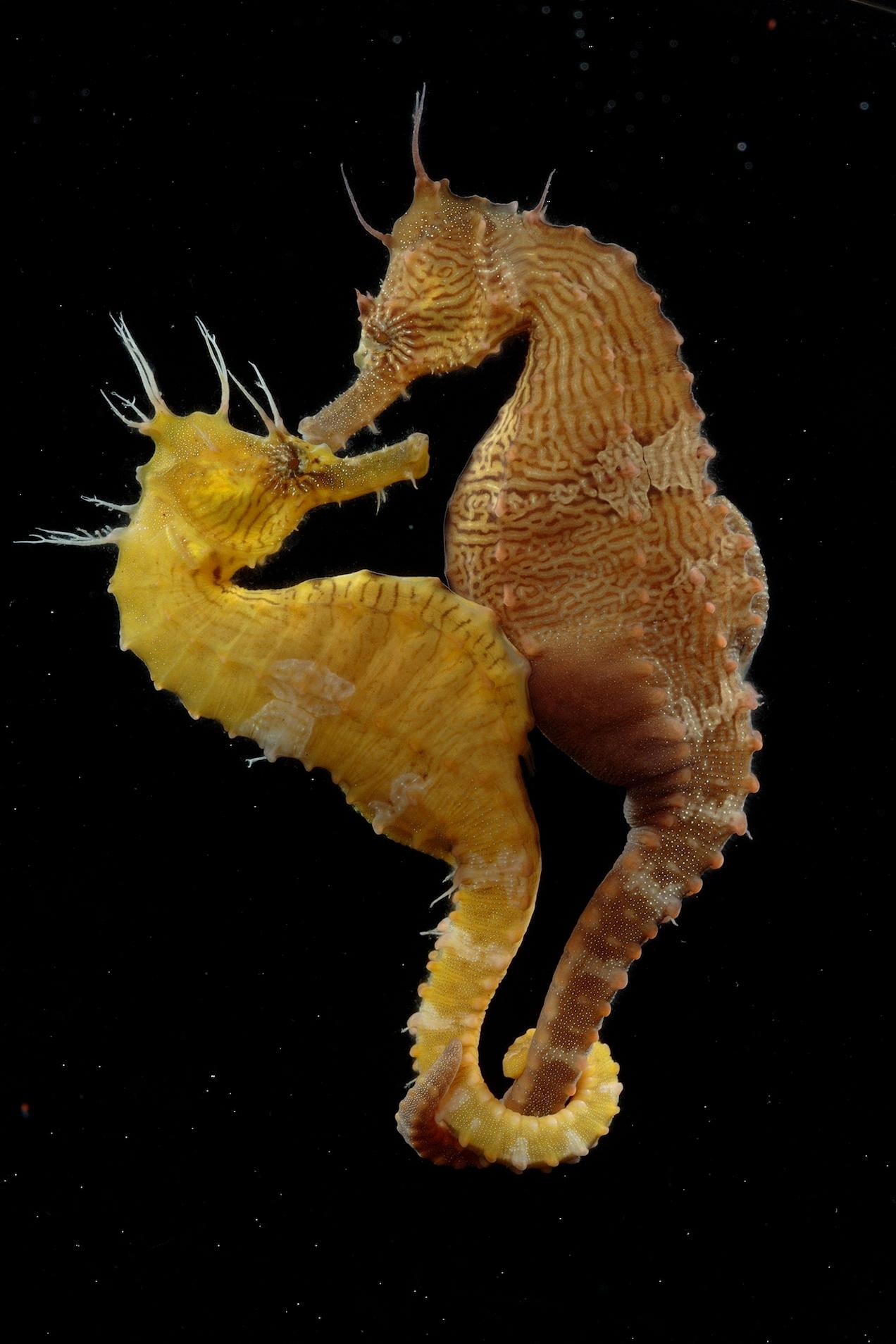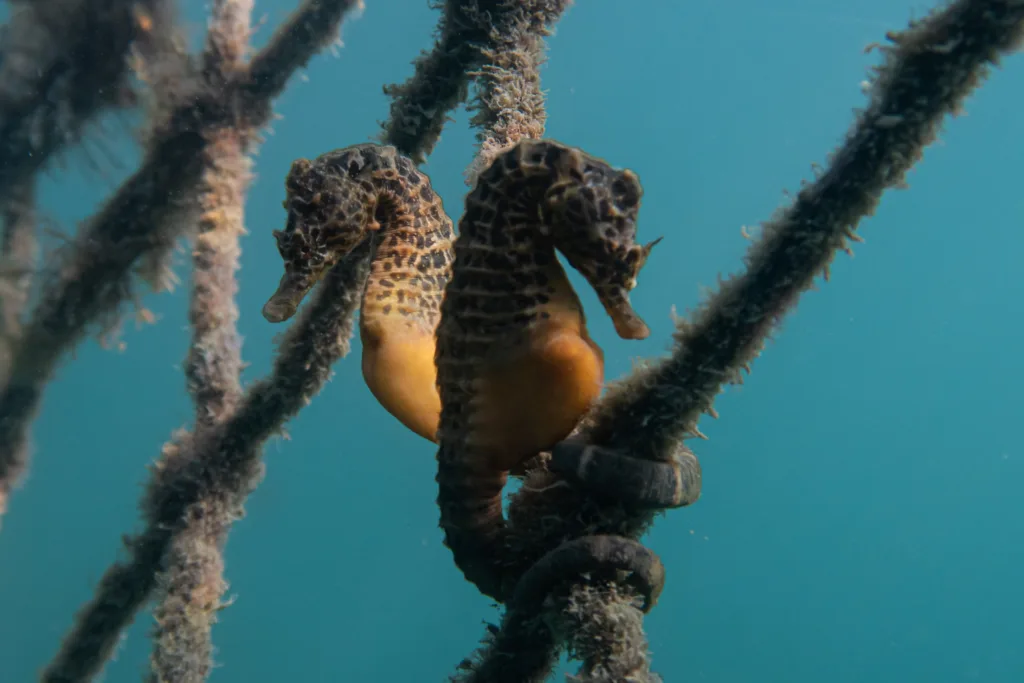Seahorses are unique creatures that belong to the Syngnathidae family which also includes pipefish and sea dragons. They are known for their distinctive appearance, their ability to change color, and their unusual mating habits.
Unlike most other fish, seahorses are monogamous and mate for life. They find a companion that they’ll stay with for the rest of their lives. However, a few species of seahorses are polygamous and change mates from one breeding cycle to the next. Regardless of their mating habits, all species of seahorse mate with only one individual per breeding cycle.
Seahorses reproduce in an unusual way. The female transfers her eggs to the male’s abdominal pouch, made of modified skin. The male releases sperm to fertilize the eggs as they enter his pouch. Then he incubates them for 24 days until they are born. This is a unique characteristic of seahorses as the sperm-producers are also the ones that get pregnant.
During the mating ritual, the seahorses engage in an intricate dance. They intertwine their tails and swim together in a circular motion. This dance is essential for helping the male seahorse to receive the eggs from the female and for fertilizing them.
After the eggs are transferred to the male’s pouch, he takes on the responsibility of incubating them. He carefully regulates the oxygen and temperature inside the pouch to ensure the embryos develop properly. This process can be taxing on the male seahorse, as he must provide nutrients and oxygen to the developing embryos.
Once the seahorse babies are born, they are fully independent and must fend for themselves. The male seahorse does not provide any further care for the babies afer they are born.
The mating habits of seahorses are unique and fascinating. They are monogamous creatures that mate for life, and the male seahorse is the one that becomes pregnant and incubates the eggs. Their intricate dance during the mating ritual is essential for fertilization, and the male seahorse takes on the responsibility of caring for the embryos. seahorses are truly one of the most interesting creatures in the ocean.
How Female Seahorses Become Pregnant
Female seahorses do not get pregnant. In fact, it is the male seahorse that carries the eggs and gives birth to the young ones. The female seahorse transfers her eggs to the male’s abdominal pouch, whch is a specialized structure made of modified skin. Once the eggs are inside the pouch, the male releases his sperm to fertilize them. The eggs then start developing and growing inside the pouch, where they receive nutrients from the male’s blood vessels. The male seahorse incubates the eggs for about 24 days before giving birth to fully-formed young ones. This unique reproductive system is one of the most fascinating features of seahorses, and it sets them apart from most other species in the animal kingdom.

Source: nationalgeographic.com
The Longevity of Seahorse Mateships
Seahorses, which are a type of fish, are known for their unique and fascinating mating habits. Unlike most fish species, seahorses are monogamous and mate for life. This means that they will only mate with one oher seahorse for their entire lives, and they will remain with that mate until one of them dies.
Seahorses are known for their elaborate courtship rituals, which involves dancing and changing colors to attract a mate. Once they find a suitable partner, they will move in together and begin to breed. The male seahorse will carry the eggs in a pouch on his abdomen, and will protect them until they hatch.
The length of time that seahorses stay with their mates can vary, but in general, they will stay together for the rest of their lives. This can be several years or even up to a decade or more, depending on the species of seahorse and their individual lifespan.
It is worth noting that seahorses are not always able to find a suitable mate, and they may remain single for their entire lives. This is particularly true for male seahorses, who are responsible for carrying and protecting the eggs. If they are unable to find a female to mate with, they will not be able to reproduce.
Seahorses are monogamous and mate for life. They will stay with their mate until one of them dies, which can be several years or even up to a decade or more. However, not all seahorses are able to find a mate, and they may remain single for their entire lives.
Asexual Reproduction in Seahorses
Seahorses do not reproduce asexually. In fact, seahorses reproduce in a very unique and interesting way. Unlike most other animals, it is the male seahorse that becomes pregnant and carries the babies to term.
Seahorses are monogamous and mate for life. During the mating process, the male and female seahorse perform a dance together, whereby they change colors and swim around each other. Eventually, the female seahorse will deposit her eggs into the male’s brood pouch, which is located on the front of his body.
Once the eggs are inside the male’s pouch, they are fertilized by the male’s sperm. The male then carries the eggs inside his pouch, providing them with nutrients and oxygen until they are ready to be born. The gestation period for seahorses varies depending on the species, but it can range from a few weeks to several months.
When the time coes for the babies to be born, the male seahorse will go through a series of contractions and give birth to the fully formed baby seahorses. This process can take several hours and the male seahorse can give birth to anywhere from a few dozen to a few hundred babies at once.
The unique reproductive process of seahorses is one of the most fascinating in the animal kingdom. Their monogamous mating habits and the fact that the male becomes pregnant make them truly one-of-a-kind creatures.
Do Seahorses Form Lifelong Mating Pairs?
Seahorses are fascinating creatures that are kown for their unique physical appearance and interesting behavior. One of the most interesting aspects of seahorse behavior is their mating habits.
Most species of seahorses are monogamous and mate for life, meaning that they choose one mate and remain with that mate for the rest of their lives. This is a rare behavior in the animal kingdom, and it is one of the reasons that seahorses are so unique.
There are a few species of seahorses that are polygamous and change mates from one breeding cycle to the next. However, even in these species, seahorses mate with only one individual per breeding cycle.
Seahorses form strong bonds with their mates and engage in elaborate courtship rituals before mating. During these rituals, the male seahorse will perform a dance for the female and may even change colors or inflate his pouch to impress her. Once the female has chosen a mate, the pair will engage in a complex mating dance that can last for several hours.
After mating, the female seahorse will deposit her eggs into the male’s pouch, where he will fertilize them and carry them until they hatch. This process can take several weeks, during which time the male will protect the eggs and provide them with oxygen.
Most species of seahorses are monogamous and mate for life, although a few species are polygamous and change mates from one breeding cycle to the next. Regardless of their mating habits, all seahorses mate with only one individual per breeding cycle and form strong bonds with their mates.

Conclusion
Seahorses mate in a unique way that sets them apart from other marine species. They form monogamous relationships and mate for life, with the male becoming pregnant instead of the female. The female transfers her eggs to the male’s abdominal pouch, where they are fertilized by the male’s sperm, and incubated for 24 days until they are born. This process, although unusual, has allowed seahorses to thrive in their underwater habitats and establish strong family units. The fascinating mating behavior of seahorses is just one example of the diversity and complexity of the natural world.
